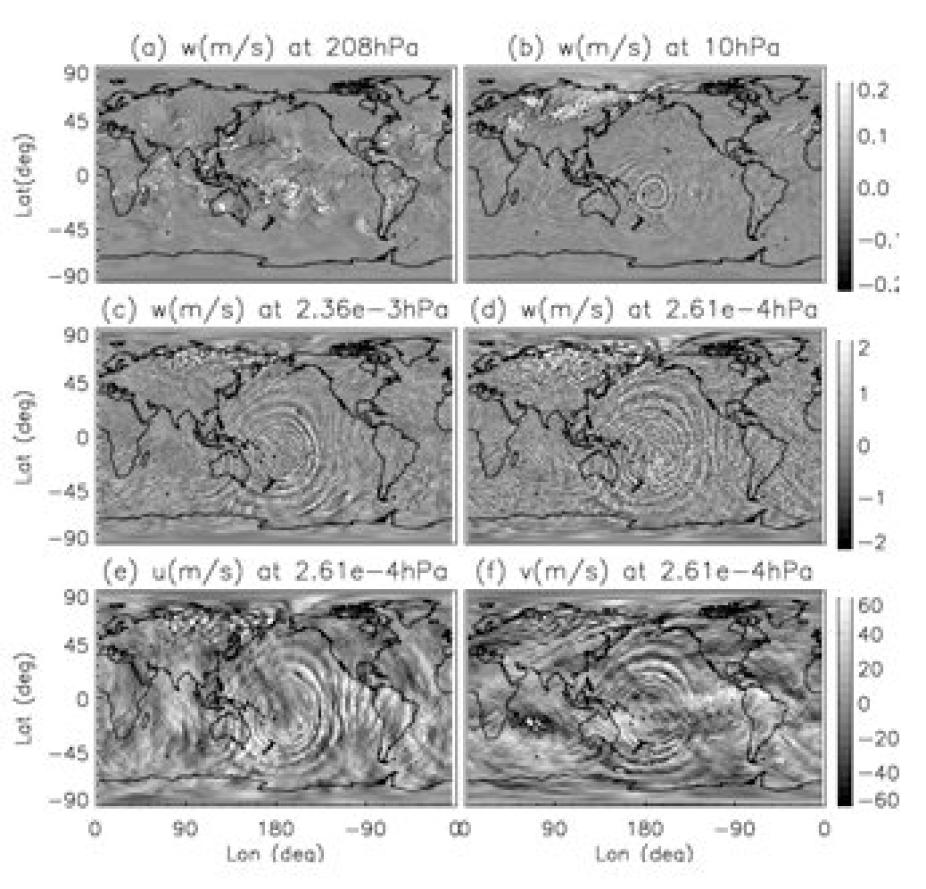Studying Atmosphere Coupling Using Mesoscale-resolving WACCM
An important pathway for the terrestrial weather to affect the space weather is through atmosphere waves, such as atmospheric tides, planetary waves and gravity waves. The impacts of the planetary-scale waves have been extensively studied observationally and numerically. The gravity waves, in spite of their increasing significance at high altitudes in causing large disturbances in the thermosphere and ionosphere, are poorly quantified in the global context. This is mainly due to the very broad scales of these waves and the wave impacts, and it is a major challenge to capture such broad scales in observations and numerical models. To address this challenge, a mesoscale-resolving whole atmosphere general circulation model has been developed for the first time. This was accomplished using the National Center for Atmospheric Research Whole Atmosphere Community Climate Model (WACCM) with ∼0.25° horizontal resolution and 0.1 scale height vertical resolution above the middle stratosphere (higher resolution below). This was made possible by the high accuracy and high scalability of the spectral element dynamical core from the High-Order Method Modeling Environment (HOMME). The latitude-height structure and the magnitudes of the temperature variance, reflecting the gravity wave potential energy density, compare well with those deduced from the Sounding of the Atmosphere using Broadband Emission Radiometry (SABER) observations.

Figure 1: WACCM simulation results on 4 February at 21:00 UT. (a–d) Vertical winds at 208 hPa (∼11 km), 10 hPa (∼30 km), 2.4 ×10−3 hPa (∼87 km), and 2.6 ×10−4 hPa (∼100 km), respectively. (e-f) Zonal and meridional winds at 2.6 ×10−4 hPa. The contour range is smaller than the actual range of the winds to better visualize the wave structures. In Figure 1a the maximum upward wind over the tropical cyclone is 4 m s−1; in Figures 1b-d the maximum values of the vertical winds are 0.6 m s−1, 9 m s−1, and 7.5 m s−1, respectively; in Figures 1e and 1f the maximum values of the horizontal winds are 162 m s−1 and 114 m s−1.
The simulation reveals the increasing dominance of gravity waves (GWs) at higher altitudes through both the height dependence of the kinetic energy spectra, which display a steeper slope (∼−3) in the stratosphere and shallower slopes above, and the increasing magnitude and spatial extent of GWs (including a planetary-scale extent of a concentric GW excited by a tropical cyclone) at higher altitudes (Figure 1). GW impacts on the large-scale flow are evaluated in terms of zonal mean zonal wind and tides: with no GW drag parameterized in the simulations, forcing by resolved GWs does reverse the summer mesospheric wind, albeit at an altitude higher than climatology, and only slows down the winter mesospheric wind without closing it. The hemispheric structures and magnitudes of diurnal and semidiurnal migrating tides compare favorably with observations.
In addition to NSF base funding on Award #M0856145, this work was supported by NSF AGS-1138784, NASA LWS NNX09AJ83G, NNX13AE20G, and base fund.
Source: Liu, H.-L., J. M. McInerney, S. Santos, P. H. Lauritzen, M. A. Taylor, and N. M. Pedatella (2014), Gravity waves simulated by high-resolution Whole Atmosphere Community Climate Model, Geophys. Res. Lett., 41, 9106–9112, doi:10.1002/2014GL062468.